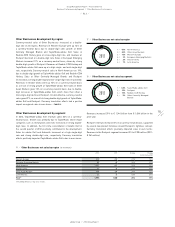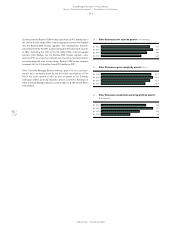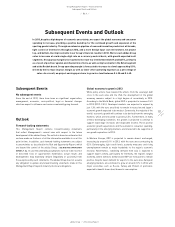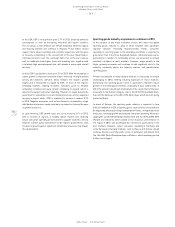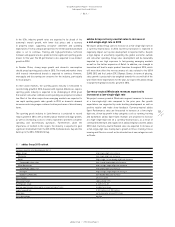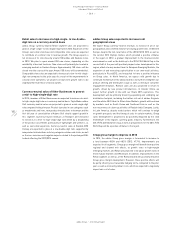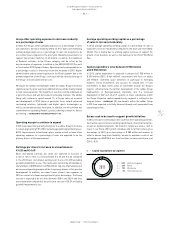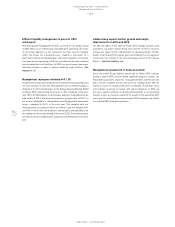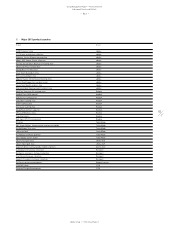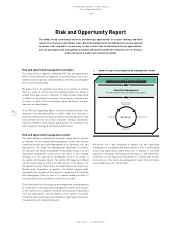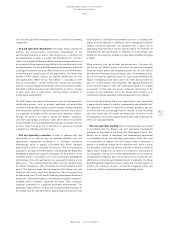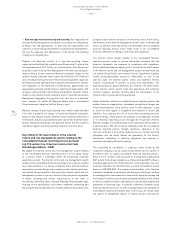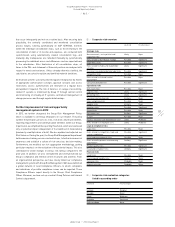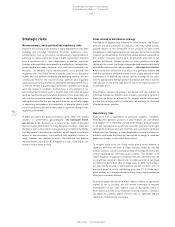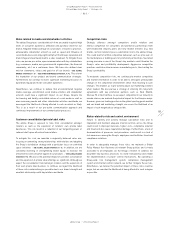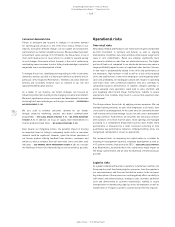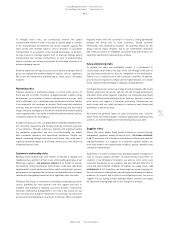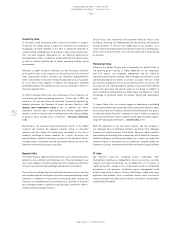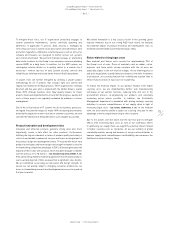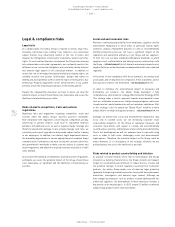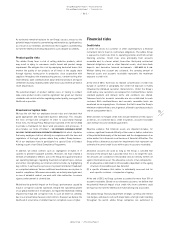Reebok 2012 Annual Report Download - page 187
Download and view the complete annual report
Please find page 187 of the 2012 Reebok annual report below. You can navigate through the pages in the report by either clicking on the pages listed below, or by using the keyword search tool below to find specific information within the annual report.
adidas Group
/
2012 Annual Report
Group Management Report – Financial Review
165
2012
Risk and Opportunity Report
/
03.5
/
Our risk and opportunity management process contains the following
components:
/
Risk and opportunity identification: The adidas Group continuously
monitors the macroeconomic environment, developments in the
sporting goods industry, as well as internal processes, to identify risks
and opportunities as early as possible. The Risk Owners (i.e. all direct
reports to the adidas AG Executive Board and the managing directors of
all our markets) have primary responsibility for the identification of risks
and opportunities. The Group Risk Management department has defined
a catalogue of potential risk areas (Risk Universe) to assist Risk Owners
in identifying and categorising risks and opportunities. Our Group-wide
network of Risk Owners ensures an effective identification of risks
and opportunities. While various Risk Owners – according to their
area of responsibility – actively monitor the overall macroeconomic,
political, social and regulatory landscape, others closely observe brand,
distribution channel and price point developments as well as changes
in other areas such as input prices, financial market conditions or
technological developments.
The Risk Owners use various instruments in the risk and opportunity
identification process, such as primary qualitative and quantitative
research including trend scouting, consumer surveys as well as feedback
from our business partners and controlled space network. These efforts
are supported by global market research and competitor analysis.
Through this process, we seek to identify the markets, categories,
consumer target groups and product styles which show most potential
for future growth at a local and global level. Equally, our analysis focuses
on those areas that are at risk of saturation, or exposed to increased
competition or changing consumer tastes.
/
Risk and opportunity evaluation: In order to manage risks and
opportunities in an effective way, we evaluate identified risks and
opportunities individually according to a systematic evaluation
methodology, which is applied consistently and allows adequate
prioritisation as well as allocation of resources. Risk and opportunity
evaluation is also part of the Risk Owners’ responsibility. The Group Risk
Management department supports and guides the Risk Owners in the
evaluation process. According to our risk and opportunity management
methodology, risks and opportunities are evaluated by looking at two
dimensions – the potential (financial) impact and the likelihood that
this impact materialises, both considering the upcoming twelve-month
period. This does not mean that the respective Risk Owners are only
looking at risks from a short-term perspective. Their assessment also
includes a mid-term (12 to 24 months) and long-term (beyond 24 months)
perspective. The potential impact is evaluated by utilising five categories:
marginal, minor, moderate, significant and major. These categories
represent quantitative or equivalent qualitative measurements. The
quantitative measurements are based on the potential financial effect on
the relevant income statement metrics (operating profit, financial result
or tax expenses). Qualitative measurements used are, for example, the
degree of media exposure or additional senior management attention
needed. Likelihood represents the possibility that a given risk or
opportunity may materialise with the specific impact. The likelihood of
individual risks and opportunities is evaluated on a percentage scale
divided into five categories: unlikely, possible, likely, probable and highly
probable.
When assessing risks, we consider two perspectives – the gross risk
and the net risk. While the gross risk reflects the worst-case negative
(financial) impact before any mitigating actions, the net risk reflects
the expected remaining (financial) impact after all mitigating actions.
On the one hand, this approach allows for a good understanding of the
impact of mitigating action taken, and on the other hand provides the
basis for scenario analysis and simulations. We regularly measure the
actual financial impact of risks that materialised against the original
assessment. In that way, we ensure continuous monitoring of the
accuracy of risk evaluations across the Group, which enables us to
continuously improve evaluation methodology based on our findings.
In assessing the potential effect from opportunities, each opportunity
is appraised with respect to viability, commerciality and potential risks.
This approach is applied to longer-term strategic prospects but also
to shorter-term tactical and opportunistic initiatives at both the Group
and, more extensively, the market and brand level. In contrast to the
risk evaluation, we do not distinguish between gross and net perspective
when assessing opportunities.
/
Risk and opportunity handling: Risks and opportunities are treated
in accordance with the Group’s risk and opportunity management
principles as described in the Group Risk Management Policy. Risk
Owners are in charge of developing and implementing appropriate
risk-mitigating actions and exploiting opportunities within their area
of responsibility. In addition, the Risk Owners need to determine a
general risk handling strategy for the identified risks, which is either
risk avoidance, risk reduction with the objective to minimise (financial)
impact and/or likelihood of occurrence, risk transfer to a third party or
risk acceptance. The decision on the implementation of the respective
risk handling strategy also takes into account the costs in relation to the
effectiveness of any planned mitigating actions if applicable. The Group
Risk Management department works closely with the Risk Owners to
monitor the continuous progress of planned mitigating actions and
assess the viability of already implemented mitigating actions.


